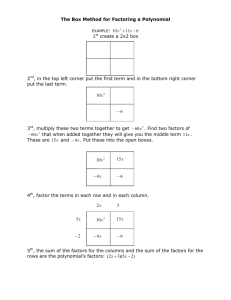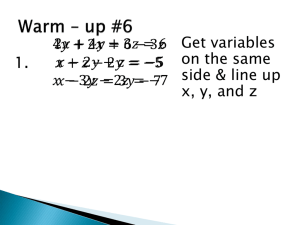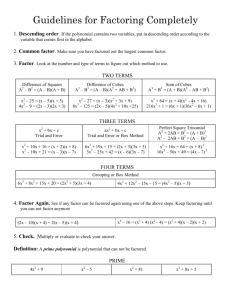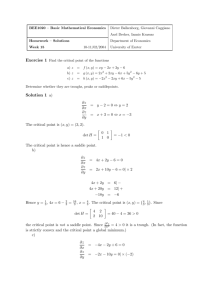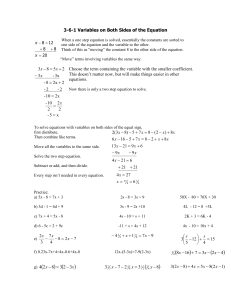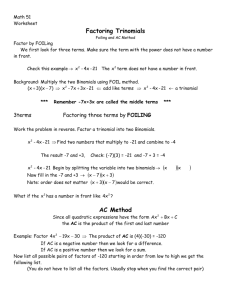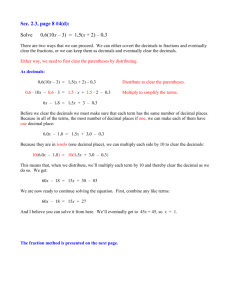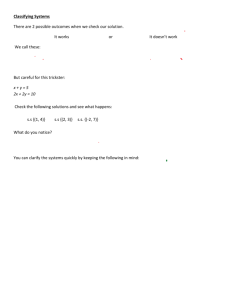Section 10.1 Systems of Linear Equations in Two Variables
advertisement
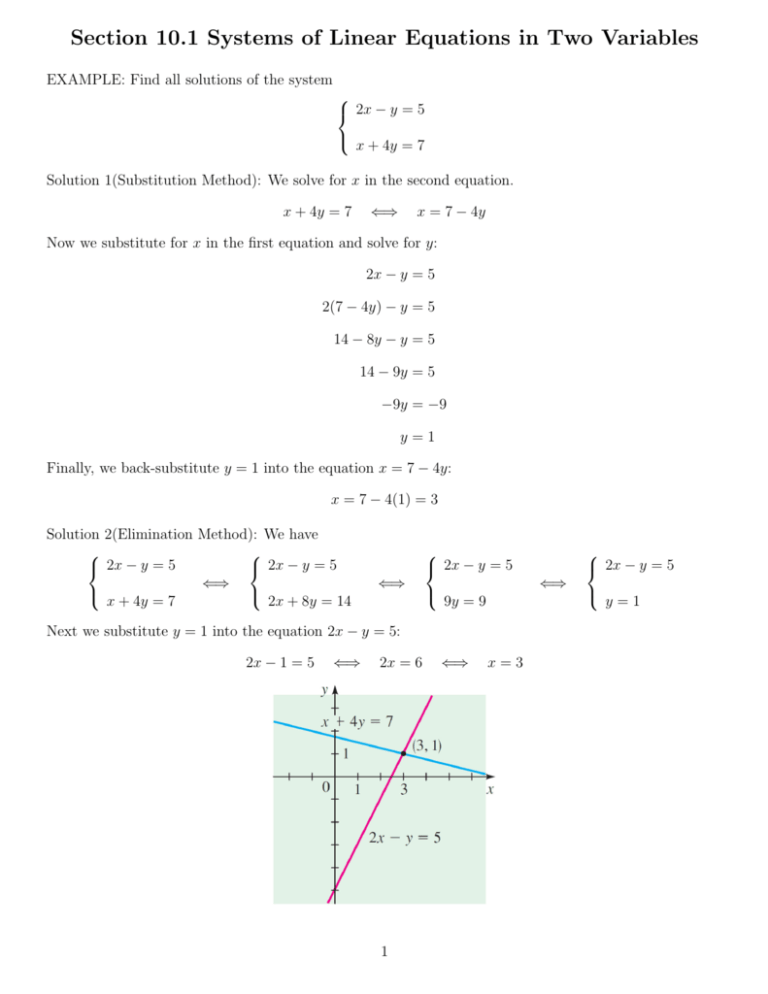
Section 10.1 Systems of Linear Equations in Two Variables EXAMPLE: Find all solutions of the system 2x − y = 5 x + 4y = 7 Solution 1(Substitution Method): We solve for x in the second equation. x + 4y = 7 x = 7 − 4y ⇐⇒ Now we substitute for x in the first equation and solve for y: 2x − y = 5 2(7 − 4y) − y = 5 14 − 8y − y = 5 14 − 9y = 5 −9y = −9 y=1 Finally, we back-substitute y = 1 into the equation x = 7 − 4y: x = 7 − 4(1) = 3 Solution 2(Elimination Method): We have 2x − y = 5 2x − y = 5 ⇐⇒ 2x + 8y = 14 x + 4y = 7 ⇐⇒ Next we substitute y = 1 into the equation 2x − y = 5: 2x − 1 = 5 ⇐⇒ 2x = 6 1 2x − y = 5 9y = 9 ⇐⇒ x=3 ⇐⇒ 2x − y = 5 y=1 EXAMPLE: Find all solutions of the system 2x + y = 1 3x + 4y = 14 Solution 1(Substitution Method): We solve for y in the first equation. 2x + y = 1 y = 1 − 2x ⇐⇒ Now we substitute for y in the second equation and solve for x: 3x + 4y = 14 3x + 4(1 − 2x) = 14 3x + 4 − 8x = 14 −5x = 10 x = −2 Finally, we back-substitute x = −2 into the equation y = 1 − 2x: y = 1 − 2(−2) = 5 Solution 2(Elimination Method): We have 2x + y = 1 8x + 4y = 4 ⇐⇒ 3x + 4y = 14 3x + 4y = 14 ⇐⇒ 5x = −10 ⇐⇒ 3x + 4y = 14 x = −2 3x + 4y = 14 Next we substitute x = −2 into the equation 3x + 4y = 14: 3(−2) + 4y = 14 ⇐⇒ −6 + 4y = 14 2 ⇐⇒ 4y = 20 ⇐⇒ y=5 EXAMPLE: Find all solutions of the system 2x + 3y = −4 5x − 7y = 1 Solution 1(Substitution Method): We solve for x in the first equation. 2x + 3y = −4 ⇐⇒ 2x = −4 − 3y x=− ⇐⇒ 4 + 3y 2 Now we substitute for x in the second equation and solve for y: 5x − 7y = 1 −5 4 + 3y − 7y = 1 2 −5(4 + 3y) − 14y = 2 −20 − 15y − 14y = 2 −29y = 22 y=− Finally, we back-substitute y = − 22 29 4 + 3y 22 into the equation x = − : 29 2 4 + 3 − 22 25 29 x=− =− 2 29 Solution 2(Elimination Method): On the one hand, we have 10x + 15y = −20 2x + 3y = −4 =⇒ ⇐⇒ 10x − 14y = 2 5x − 7y = 1 On the other hand, we have 2x + 3y = −4 5x − 7y = 1 ⇐⇒ 14x + 21y = −28 =⇒ 15x − 21y = 3 EXAMPLE: Find all solutions of the system 3 1 7 −5x + 2y = 2 1x + 4y = 3 3 5 2 3 29y = −22 ⇐⇒ y=− 22 29 29x = −25 ⇐⇒ x=− 25 29 EXAMPLE: Find all solutions of the system 3 1 7 −5x + 2y = 2 1x + 4y = 3 3 5 2 Solution (Elimination Method): We have 1 7 3 −5x + 2y = 2 1x + 4y = 3 3 5 2 On the one hand, we have −6x + 5y = 35 ⇐⇒ 10x + 24y = 45 On the other hand, we have −6x + 5y = 35 ⇐⇒ 10x + 24y = 45 ⇐⇒ −6x + 5y = 35 −30x + 25y = 175 =⇒ 97y = 310 ⇐⇒ y= 30x + 72y = 135 −144x + 120y = 840 10x + 24y = 45 =⇒ −194x = 615 x=− ⇐⇒ 50x + 120y = 225 EXAMPLE: Find all solutions of the system x+y =1 x+y =2 Answer: The system has no solution (inconsistent). EXAMPLE: Find all solutions of the system 15x − 10y = 25 Solution: We have 15x − 10y = 25 −24x + 16y = −42 ⇐⇒ −24x + 16y = −42 3x − 2y = 5 3x − 2y = 21 4 It follows that the system has no solution (inconsistent). EXAMPLE: Find all solutions of the system x+y =1 x+y =1 4 ⇐⇒ 3x − 2y = 5 0= 310 97 1 4 615 194 Answer: The system has infinitely many solutions (dependent). EXAMPLE: Find all solutions of the system 15x − 10y = 25 Solution: We have 15x − 10y = 25 −24x + 16y = −40 −24x + 16y = −40 ⇐⇒ 3x − 2y = 5 ⇐⇒ 3x − 2y = 5 It follows that the system has infinitely many solutions (dependent). 5 3x − 2y = 5 0=0
